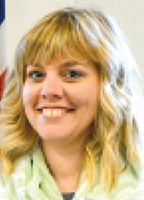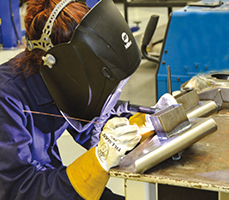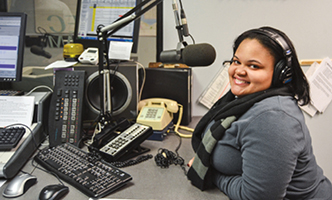
|
| Julie Lenner-McDonald |
The charge from our school board back in 2014 came loud and clear: Transform how we are serving students in the Sandusky City Schools so they can compete globally.
The board of education in our city of 25,000 on the shores of Lake Erie demanded progressive change as the area wrestled with the aftermath of the Great Recession. The district had lost 25 percent of its students as families moved away for several reasons, the loss of employment being a prominent factor.
For a community steeped in rich tradition tied to an industrial America, Sandusky had a desperate need to revitalize itself. The urgency was palpable.
A New Reality
The city’s school system, with its 3,200 students, is the center of the community’s pride. To be a Sandusky High School graduate is the culminating event for generations of families. Graduates historically followed their relatives into the city’s manufacturing jobs if they didn’t head off to college. With the closure of many large factories and smaller businesses, employment options dwindled for new high school graduates as well as college graduates looking to return home to start their work lives.
The new reality forced our school district to take a hard look at what we were offering students to help them compete. What did it mean now to be a Sandusky High School graduate? How would we operationalize our Pride Tradition Excellence tagline in a meaningful way?
District and building-level administrators jointly identified the areas at Sandusky High School that were producing results, defined real and perceived barriers in other areas and began to problem solve. The superintendent involved the entire district in what he called the Transformation Plan, a five-year strategic plan targeting 12 areas, including overall academics, college and career readiness and adult education.
Sandusky had prided itself on its comprehensive status. Students could take career technical classes in business, cosmetology, health careers and other fields, while others had access to Advanced Placement courses and college credits through dual enrollment at postsecondary institutions.
Between these two strengths however, we discovered students who were telling us they were entering the workforce directly after graduation with little or no experience and without credentials needed for gainful employment at a livable wage. This was unacceptable.
Missing Skills
We asked ourselves, what jobs were these students competing for nearly two decades into the 21st century? In conversations with area employers and city leaders in economic development, we found jobs were available to high school graduates, but the applicants lacked the skills they were seeking.
The missing skills fell into two categories: hard, measurable skills for carrying out the expected tasks, and the soft skills of professionalism on the job, including appearance, perseverance, collaboration and acceptance of criticism. Further, many of the job openings were in newly emerged fields that did not exist when the parents were starting out on their career paths.

|
A Sandusky High School student intern at ThorSport Racing practiced her welding skills on NASCAR vehicles.
|
Notably, exposure to STEAM careers in our community was lacking. Do our students know what really happens at Mack Iron Works, a company that has operated in Sandusky for more than 100 years? Beyond the drivers racing for ThorSports, do our students know what happens behind the scenes for teams competing in NASCAR? What careers exist at our local hospitals?
Additionally, the economics associated with workforce development did not go unnoticed by the city’s elected leaders and the economic development corporation. To revitalize Sandusky, the city would need to bring new businesses to the area. The recruitment’s success would be tied to the availability of a viable workforce.
A Tailored Experience
Our answer as a school district has become known as the Global Internship Program. Identified in the Transformation Plan, the program exposes all seniors to careers associated with their postsecondary interests. The formal mission states: “We believe in preparing students for college, career and military readiness to compete in a global society. By forming strong bonds in our community, students gain a sense of pride and develop positive relationships that will help strengthen our community.”
Students enroll during their senior year, and their experiences are tailored to their non-academic schedules (sports, employment, family responsibilities). All student experiences are required to have a global connection.
To create placements, Erin Cremean, coordinator of the Global Internship Program, has worked with more than 200 businesses, nonprofit organizations and government agencies. Most options are in the fields of science, technology, engineering, arts and mathematics, including a nanotechnology firm, a food processing plant, ThorSport Racing and NASA. The program offers small-group on-site visits, job shadowing and internships that last from a few days to a semester or longer.
Before beginning an internship, students spend the first semester of senior year learning the soft skills employers seek: resume writing, oral communication, interviewing and professional behavior. The senior seminars feature a speaker from the community who shares the realities of the workplace. The first eye-opener is that students do not always get their first choice of internship, as some are highly selective.
The program in 2017-18, its third year, had 100 participating students in a senior class of 172. We expect more involvement in each school year.

|
Sandusky student Kharisda Johnson interned at BAS Broadcasting, an FM radio station, where she was a host on the daily morning show before continuing her broadcasting studies at Howard University in Washington, D.C.
|
Measuring Satisfaction
The pilot year yielded valuable feedback from students and internship sites. Logistics came up commonly. Coordinating students’ academic schedules for release time, securing transportation to and from worksites, and addressing the demands of host organizations have been difficult at times, but barriers have lessened as the program has grown.
Cremean works with internship sites’ human resource departments as well as in-house counsels to ensure protocols are followed. The culminating activity is our Global Intern Night, where students share their workplace experiences with their internship mentors, fellow students and families.
The Global Internship Program’s effectiveness is measured through student satisfaction and site satisfaction surveys, employment offers upon completion of internships and identification of a fitting college major. Several students have altered their academic plans based on their experiences, and some have been offered full-time jobs with livable salaries upon graduation. Additionally, students have continued in paid positions during college breaks.
Our greatest gratification often comes from hearing directly from participating students, some of whom are breaking down age-old barriers.
Caitlyn Brunow, who graduated in June from Sandusky, spent the second half of her senior year as the first female welder at Mack Iron, a 117-year-old Sandusky-based company with clients in much of Europe, Saudi Arabia, Singapore and Malaysia.
“I used to be terrified and nervous to do projects for my class or even for work,” she admits. “But ever since I started at Mack Iron, I have learned to be confident of myself and my welding skills. If my coworkers give me a job to do, I get it done confidently and correctly without the fear of messing up.”
JULIE LENNER-MCDONALD is chief academic officer of the Sandusky City Schools in Sandusky, Ohio. Twitter:
@jlmcdonald